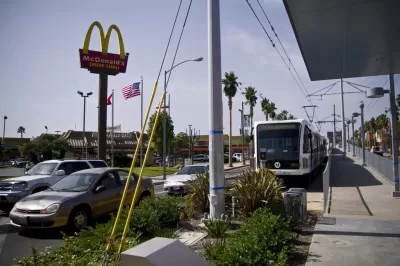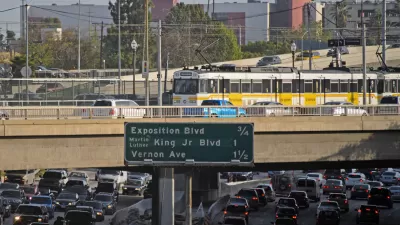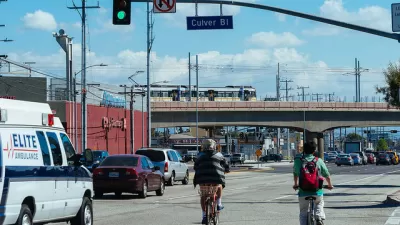More Southern Californians are purchasing motor vehicles, particularly those who were previously transit-dependent, which largely explains the region's declining transit ridership, according to a newly released study.

The report, Falling Transit Ridership: California and Southern California, by Michael Manville, Brian D. Taylor, and Evelyn Blumenberg of the UCLA Institute of Transportation Studies, was released Jan. 31. Commissioned by the six-county Southern California Association of Governments (SCAG), it was written to better understand the trend of falling transit ridership and help inform planners and policymakers on how to address it.
"Although the research was limited to Southern California, it could have big implications if similar patterns are found elsewhere," writes Governing’s transportation and infrastructure reporter, Daniel C. Vock.
As posted last month, transit ridership in Los Angeles County dropped 15 percent in 5 years despite the opening of new light rail extensions.
Experts and officials have no firm answers, but have attributed the decline to a combination of factors, including changes to immigration policy, competition from Uber and Lyft and more people buying cars — as well as perceived problems with existing transit service and security, wrote Laura J. Nelson, who covers transportation and mobility issues across Southern California for the Los Angeles Times, on Jan. 25.
"As data has revealed multi-year decreases of up to 25% [across Southern California], experts and officials have stopped debating whether the decline exists, and have instead turned their attention to why," writes Nelson on Feb. 1.
The study of U.S. Census data and ridership figures, prepared by the UCLA Institute of Transportation Studies, called the increase in car ownership a "smoldering, if not a smoking, gun" to suggest why transit ridership across the region fell by 72 million trips over a five-year period.
Auto ownership data backs up that assertion. According to the study:
Between 2000 and 2015, private vehicle ownership dramatically increased among households in the SCAG region, from 1.7 to 2.4 vehicles per household. During the 1990s, the region grew by 1.8 million people and 456,000 household vehicles, or 0.25 cars per new resident. But from 2000 to 2015, the region added 2.3 million people and 2.1 million household vehicles, nearly one car per new resident.
To exacerbate transit's ridership loss, "car ownership has grown fastest among the most frequent transit riders," write the authors. Here's where the report's finding may not be transferable to areas with more widespread, demographic transit usage, rather than focused on those who are transit-dependent, lower income, and often immigrants.
A small portion of Southern California residents take the majority of all transit trips: Less than 3 percent of the region’s population rides transit very frequently, another 20 percent rides occasionally, and more than three-quarters of residents ride transit rarely or never
"It's unclear what was driving the higher vehicle ownership rates, especially because wages were stagnant," writes Vock of Governing.
But there are many indications that low-income consumers are taking on more vehicle-related debt. Between 2000 and 2015, inflation-adjusted per capita vehicle debt in California rose 91 percent, according to the study.
[Co-author] Evelyn Blumenberg says vehicles could be more of a necessity among low-income residents because jobs and housing continue to spread into suburban areas.
Co-author Brian D. Taylor has for years urged transit agencies to focus on denser areas best served by transit, adds Vock.
“The biggest declines have been on the best lines in the whole state,” Taylor wrote. This evidence is consonant with these “neighborhoods becoming more affluent, with that affluence being associated with less transit use and with people left out of that affluence remaining on transit."
A contrasting perspective is offered on Feb. 6 by Planetizen blogger, Michael Lewyn, although he looks at nationwide transit ridership decline.
Streetsblog LA's Joe Linton offers a critical review of the UCLA-ITS report. "[T]he diagnosis is far from conclusive, and nearly no prescriptions are offered," he writes. Linton also contrasts ridership data with other metropolitan regions.
From 2000 to 2016, the Bay Area and San Diego area saw modest increases in transit ridership. California ridership was down due to declines in L.A. and Orange Counties.
That observation helps to explain how the SCAG six-county region of Imperial, Los Angeles, Orange, Riverside, San Bernardino, and Ventura Counties was responsible for 120 percent of the state's total transit trip loss from 2012 to 2016, a bewildering finding stated on the report's webpage.
"Bay Area transit agencies, including San Francisco's Muni, have bucked the declining ridership trend, with trips increasing by 20%," observed Nelson of the Times.
What about ride-hailing?
So much for those surveys that suggested ride-hailing would lead to a reduction in car ownership. The study also explains why ride-hailing can't be blamed as the main cause of the loss of transit riders.
"Transit ridership started its decline in 2007, but the ride-hailing apps weren’t even introduced until 2009 and weren’t widely adopted until 2012," writes Vock.
“What little evidence we do have suggests that most [ride-hailing] trips do not replace transit trips,” the researchers wrote:

Depopulation Patterns Get Weird
A recent ranking of “declining” cities heavily features some of the most expensive cities in the country — including New York City and a half-dozen in the San Francisco Bay Area.

Pennsylvania Mall Conversion Bill Passes House
If passed, the bill would promote the adaptive reuse of defunct commercial buildings.

California Exodus: Population Drops Below 39 Million
Never mind the 40 million that demographers predicted the Golden State would reach by 2018. The state's population dipped below 39 million to 38.965 million last July, according to Census data released in March, the lowest since 2015.

Google Maps Introduces New Transit, EV Features
It will now be easier to find electric car charging stations and transit options.

Ohio Lawmakers Propose Incentivizing Housing Production
A proposed bill would take a carrot approach to stimulating housing production through a grant program that would reward cities that implement pro-housing policies.

Chicago Awarded $2M Reconnecting Communities Grant
Community advocates say the city’s plan may not do enough to reverse the negative impacts of a major expressway.
City of Costa Mesa
Licking County
Barrett Planning Group LLC
HUD's Office of Policy Development and Research
Mpact Transit + Community
HUD's Office of Policy Development and Research
City of Universal City TX
ULI Northwest Arkansas
Town of Zionsville
Urban Design for Planners 1: Software Tools
This six-course series explores essential urban design concepts using open source software and equips planners with the tools they need to participate fully in the urban design process.
Planning for Universal Design
Learn the tools for implementing Universal Design in planning regulations.


























